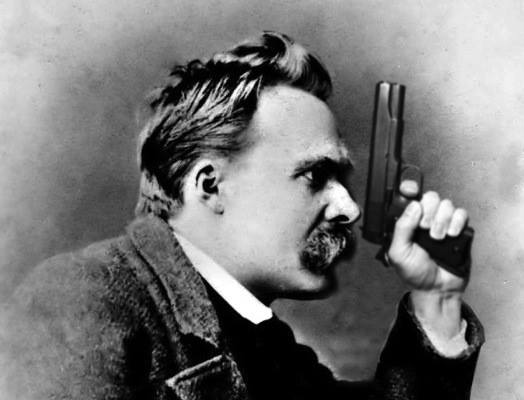by Eleanor Courtemanche
This essay was peer-reviewed by the editorial board of b2o: an online journal.
Even if we wanted to—and I’m not sure we really do, at this conference—it would be hard to read Nietzsche from a purely historicist perspective. Nietzsche casts a powerful shadow on his own futurity; we cannot but read him through subsequent history, what Megan Ward has called the “historical middle, the period between the Victorians and ourselves” (Ward 2015). Part of good scholarship, as cultural critics know, is to try to avoid dismissing Nietzsche merely because the Nazis loved him. For that misfortune we blame his anti-Semitic sister Elisabeth Förster-Nietzsche, who dressed Nietzsche up in a classical-looking toga and invited guests to gawk at the genius, in Weimar in the 1890s after his brain had been eaten away by syphilis (MacIntyre 1992). Or perhaps he didn’t have syphilis at all—an article from 2003 alleges that the explanation of Nietzsche’s dementia as syphilis was a smear by anti-Nazis after WWII, and that in fact Nietzsche might have died of a brain tumor (Matthews). The existentialists reclaimed Nietzsche after the war and popularized him in Walter Kaufmann’s translations, with introductions that were later considered too apologetic by politically more stringent cultural critics. And it’s hard to talk about Nietzsche at the University of Chicago without disturbing the shade of Leo Strauss, who may (or may not!) have created a neo-Gnostic cult of esoteric insider wisdom, training up elite cadres at Chicago and Claremont, that has given American neoconservatives the Nietzschean über-confidence to treat democracy as a noble lie for consumption by the masses (Waite 1996).
Or do we see Nietzsche as a friend and antecedent, merely one of the paragons of the hermeneutics of suspicion, forerunner of Foucault’s vision of power as dispersed and all-pervasive—and hence, in a development he would no doubt despise, the ancestor of our politically-informed “suspicious readings” that see lurking imperialism and heteronormativity everywhere? Our allegiance to this legacy of suspicious reading on some level legitimates the recent turn to historicist critique, as well as our reconsideration of that critique today.
As Victorianists, we should theoretically pay attention to none of those things. We should be trying to peel back the layers of post-hoc myth, antiquarian reverence, and political toxicity to figure out what Nietzsche meant at the time he was writing, in 1874, in the wake of German unification (an event that actually does inform Nietzsche’s whole essay). However, despite all our careful attention to the past, there is one aspect of Victorian writing we seem blind to and can’t properly describe: its lingering Platonism, with its constant appeals to something higher, purer and more noble, which we see everywhere in this essay despite Nietzsche’s reputation for anti-metaphysics. After WWII, I think, this idealism was purged from our scholarship, marking a clear distance between our values as cultural critics and those of the nineteenth century.
I personally have yet another layer of historical experience that clouds my vision here: my very first public conference paper, as a first-year grad student at Cornell in April 1992, was on this essay, “On the Use and Abuse of History for Life,” at conference on Nietzsche organized by Geoff Waite. Although I haven’t been able to access the MacWrite file, which is lost to the ages, I squirrelled away the original talk (entitled “The Boundaries of the Cultural Organism”) in a file I’ve been carrying around for unexamined sentimental reasons since then. This talk is amazing for me to read today, because, in defiance of everything I now tell my own grad students, I analyzed no sources at all outside the original text. Back then, I was so naïve that I just read Nietzsche’s essay itself and traced its component paradoxes. Nietzsche’s essay lends itself beautifully to being deconstructed: as I pointed out in my paper, in this essay you can’t actually tell the difference between the malady and the cure; the man who is merely affecting tranquility and the artist whose calm demeanor masks inner flashing life; the overripe and the not-yet-ripe; vulgar egoism and noble selfishness; the culture that has successfully internalized all barbarian attacks and forged them into something new (that is, the Greeks) versus the culture that is merely a hapless cosmopolitan aggregate (that is, the newly unified German nation). I’m sort of amazed I used to write like this—it feels kind of raw despite its sophistication. My whole paper just assumes philosophy is worth analyzing and analyzes it. Perhaps the current practice of elaborate historicism will seem just as alien to critical readers in twenty or thirty years.
There are many horizons of ignorance in Nietzsche’s essay, arranged to protect some kernel of irrational stupidity that he thinks is crucial to cultural health, but that no scholar can really defend. Sorry, Nietzsche—humans just do want to know more than we should. But the essay’s eloquent yearning to know better, to know more usefully in relation to our own lives, and with fewer veils, conventions, and compromises—that part of “On the Use and Abuse of History for Life” has not gone out of date.
References
MacIntyre, Ben. 1992. Forgotten Fatherland: The Search for Elisabeth Nietzsche. New York, Farrar Strauss & Giroux.
Matthews, Robert. 2003. “‘Madness’ of Nietzsche was cancer not syphilis.” The Telegraph, May 4. http://www.telegraph.co.uk/education/3313279/Madness-of-Nietzsche-was-cancer-not-syphilis.html.
Waite, Geoff. 1996. Nietzsche’s Corps/e: Aesthetics, Politics, Prophecy, or, The Spectacular Technoculture of Everyday Life. Durham, NC: Duke UP.
Ward, Megan. 2015. “Theorizing the Historical Middle.” V21 Collective (blog), June 1. http://v21collective.org/megan-ward-theorizing-the-historical-middle/
CONTRIBUTOR’S NOTE
Eleanor Courtemanche is Associate Professor of English, Comparative Literature, and German at the University of Illinois at Urbana-Champaign. Her book The ‘Invisible Hand’ and British Fiction, 1818-1860: Adam Smith, Political Economy, and the Genre of Realism was published in 2011.

Leave a Reply